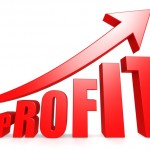If you are familiar with comic book heroes who have graduated to full-length Hollywood feature films, then you know who “Iron Man” is. You also likely know that Robert Downey, Jr. is the actor who portrays Iron Man, as well as (obviously) the man in the film who built and operates the metal robotic suit/armor that makes Iron Man “super” — Tony Stark (CEO of Stark Industries).
 However, there is a chance that you do not know the personality/career upon whom Downey based his characterization of Tony Stark!! Can you make a guess? (The image to the left is from flickr.com[1])
However, there is a chance that you do not know the personality/career upon whom Downey based his characterization of Tony Stark!! Can you make a guess? (The image to the left is from flickr.com[1])
In 2010, the answer was revealed in a magazine interview with the Jon Favreau, director of the first two Iron Man movies – Elon Musk.[2]
I hope you read (or saw) Elon’s exciting news from December 3rd: the privately owned space transport company that Musk founded in 2002 (Space Exploration Technologies Corporation, or SpaceX) completed its first commercial launch from Cape Canaveral, Florida. Just about everything about the launch was “huge”:
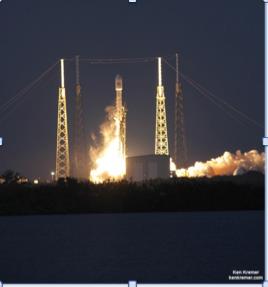 1) The rocket that was launched is an upgraded Falcon 9 – with a 50% more powerful thrust than its predecessor. That’s huge;
1) The rocket that was launched is an upgraded Falcon 9 – with a 50% more powerful thrust than its predecessor. That’s huge;
2) Because SpaceX needs a powerful multi-stage expendable rocket (such as the Falcon 9) to demonstrate it will be capable of fulfilling the 50 launches NASA is counting upon in years to come, as well as launches for other space concerns, the fact that this launch “met 100% of the mission objectives” was huge;
3) The Falcon 9 delivered a communications satellite into its targeted geostationary Earth orbit for SES World Skies[3];
a. That satellite will enable TV and communications coverage over the South Asia and Asia-Pacific regions – a huge area.
4) After the launch, Musk said: “The successful insertion of the SES-8 satellite confirms the upgraded Falcon 9 launch vehicle delivers to the industry’s highest performance standards. As always, SpaceX remains committed to delivering the safest, most reliable launch vehicles on the market today. We appreciate SES’s early confidence in SpaceX and look forward to launching additional SES satellites in the years to come!”
a. It is safe to say that Musk’s relief and his appreciation for his engineers and technicians was huge.
5) What this means for the future could be huge!
a. Up until now, overseas operators of expendable rockets have offered lower cost launches than can be found in this country.
b. Therefore, satellite operators around the globe have been booking commercial launches through those overseas firms.
c. Musk has made it clear that SpaceX’s goal is to significantly cut the cost of access to space.
d. The chief technical officer of SES, Martin Halliwell, offered this pronouncement in his enthusiasm regarding having worked with SpaceX: “This is really rocking the industry. Everybody has to look out!” That is huge.
6) To put the scale of this new Falcon rocket in clearer focus, consider these statistics:
a. The nine Merlin 1D engines provide 1.3 million pounds of thrust at sea level, and 1.5 million pounds of thrust as the rocket climbs toward orbit;
b. The engines are arranged in an “octaweb” for improved efficiency, enabling it to boost much heavier cargo loads into orbit;
c. It is 224 feet high and has a diameter of 12 feet.
i. The earlier rocket was just 130 feet tall!
ii. The Falcon 9 is “huge” indeed! (The image of the rocket launch included earlier is from Ken Kremer/kenkremer.com.)
All of the above is fascinating, but SpaceX is not publicly traded (or available): “So (why on earth) are you writing about SpaceX?”, you ask.[4] The reason couldn’t be simpler. I wanted to write about Tesla (TSLA) (another company for which Musk is CEO), so I decided that this fresh news about SpaceX’s (newest) milestone offered a “kairos moment” for a story on Elon Musk.
Before I launch into TSLA, let me just offer one huge tease[5] about SpaceX shares. Mr. Musk produced something of a mini-storm in June when he Tweeted:
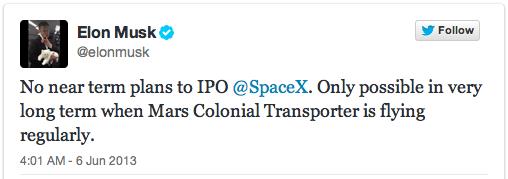 Some of the greedy among us thought: “Is he nuts? With TSLA and Solar City (SCTY)[6] in the news almost every day, he is sitting on a(nother) goldmine with SpaceX! Why wait??”
Some of the greedy among us thought: “Is he nuts? With TSLA and Solar City (SCTY)[6] in the news almost every day, he is sitting on a(nother) goldmine with SpaceX! Why wait??”
That only shows that the greedy are not deep thinkers!! That very day, Musk responded to the outcry that was questioning his sanity:
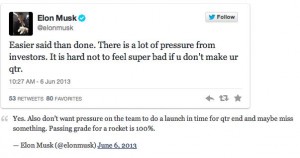 If you can’t read the postscript, it says: “Yes. Also, you don’t want pressure on the team to do a launch in time for gtr end and maybe miss something! Passing grade for a rocket is 100%.”
If you can’t read the postscript, it says: “Yes. Also, you don’t want pressure on the team to do a launch in time for gtr end and maybe miss something! Passing grade for a rocket is 100%.”
Absolutely, sir! You are right on and that is one of the best quotes I have read in a long, long time![7]
But for those of you who love IPO speculation and the volatility scene that inevitably surrounds stocks for months after an IPO… whet your lips and “get ready!” Just like we Chicago Cubs fans here in the Windy City – “There’s always next year!”
So now, on to TSLA! One very interesting new feature within the ThinkorSwim Trading Platform (through TD Ameritrade) is the “COMPANY PROFILE”. The research available there comes from Trefis.com and the platform even allows an investor to download a full research report on the company. Here is the current chart that offers a “macro view” of components that comprise the value of the TSLA.
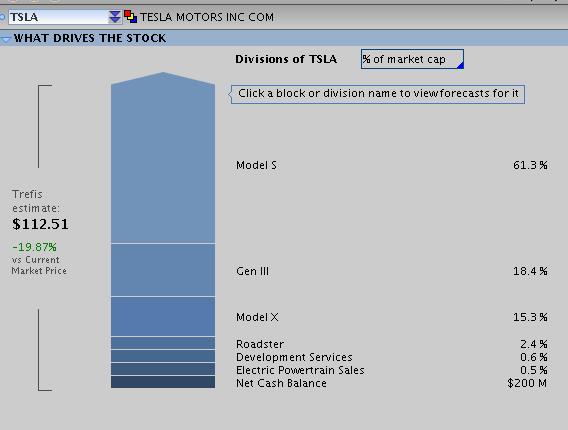 As you can see to the left, current value of TSLA is driven primarily by the Model S. The full valuation model provided is built upon a rather detailed compilation of assumptions, metrics, and projections.
As you can see to the left, current value of TSLA is driven primarily by the Model S. The full valuation model provided is built upon a rather detailed compilation of assumptions, metrics, and projections.
As an example, the model presented by Trefis projects the growth of the entire auto industry (see graph), and from that projection calculates the potential number of TSLA autos that could be sold between now and 2020 – utilizing the metrics that Electric Vehicles (EV) currently comprise 2% of all cars sold and should grow in market share to 6% (see next graph). It also projects that the TSLA EV battery/motor technology will grow in dominance within that EV space.[8]
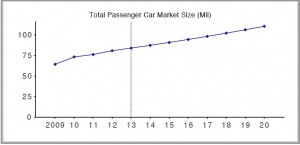 I found this report more comprehensive that the usual analytical report I am able to find and absorb .[9]
I found this report more comprehensive that the usual analytical report I am able to find and absorb .[9]
As far as Trefis is concerned, on November 14th of this year, it suggested that a logical valuation of TSLA would be approximately $113. As we remind you regularly in this space, the essence of Wall Street is that some companies are priced less than its value, while others are priced at a level higher than actual value.
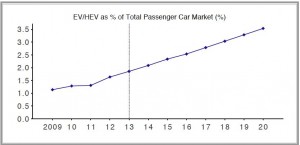 Surely you have become familiar with TSLA’s price action this year! It sat in the mid-30’s in January, February, and most of March; however, it hit $43.93 by April Fool’s Day, $53.28 by May Day, and $92.59 by June 3rd! If the story ended there, it would still have been an incredible story – up 162% between January 1st and June 3rd! I know I’d have been thrilled to have a 160%+ winner in my portfolio!
Surely you have become familiar with TSLA’s price action this year! It sat in the mid-30’s in January, February, and most of March; however, it hit $43.93 by April Fool’s Day, $53.28 by May Day, and $92.59 by June 3rd! If the story ended there, it would still have been an incredible story – up 162% between January 1st and June 3rd! I know I’d have been thrilled to have a 160%+ winner in my portfolio!
However, it did not end there. By October 1st, the price had almost hit $200, resting at $193. For the record, that is an appreciation of 446% from January1st! I think I’ll take it.
But would I, really?? Would I really have hung on from January 1st through October 1st? Would you have held TSLA shares/options all that time? If I am honest with myself, I’d have an frank, heart-to-heart chat within myself – a conversation between my mind and my gut.
My mind would say: “Are you kidding me, Petty?! Would I hang on all that time? Of course I would! I know all these cool option strategies – bull put spreads, married puts, collaring the stock, etc. There is nothing that could stop me from hanging on! They don’t call me ‘Mr. Incredible’ at my broker’s office for nothing!”
Then my gut would utter a loud rumble[10] and reply: “Give me a break, Petty. ‘Mr. Incredible?’…. Really? I think they refer to you more often like this: ‘Ah, look at all those nice commissions come rolling in like clockwork!’ So get off your high horse, Petty! You know it isn’t that easy! The wild swings in the price of TSLA,[11] the daily news stories (some scary, some encouraging), the nearly unlimited inflow of unsolicited advice, the pull of greed and push of fear. All of those make holding a TSLA a more (to coin a phrase) ‘gut-wrenching experience’ than owning Intel (INTC), Qualcomm (QCOM), Microsoft (MSFT), etc!!”[12]
However, there is a way I could hold TSLA shares a lot more easily! If a “fairy godmother” suddenly transformed me into Elon Musk (and my name was on his Balance Sheet) – I am on very solid ground suggesting that I would no longer need Tums to get through a typical trading day or Sominex to sleeop through the night!
Let’s take a look at Mr. Musk’s net worth. According to Forbes’ annual “wealth” report (see inset below), as of September of this year, Musk was worth a tidy $6.7 billion, ranking him 61st in the coveted “Forbes 400” list . Not bad for a 42 year old South African; and it could prove helpful in providing for his five children.
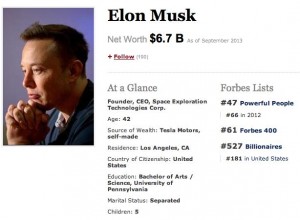 If you have been comprehending what we’ve covered thusfar, you won’t be surprised that 2013 has been a good year for Elon. Prior to November, the value of his SCTY and TSLA shares had appreciated by $2.9 billion!
If you have been comprehending what we’ve covered thusfar, you won’t be surprised that 2013 has been a good year for Elon. Prior to November, the value of his SCTY and TSLA shares had appreciated by $2.9 billion!
However, if you paid attention to my review of TSLA price action in October and November, you know that the “road to riches” with TSLA this year has been bumpy!
Let’s look at TSLA’s price chart (below). TSLA (blue) had such a parabolic rise after the first quarter that the S&P 500 Index (red) appears like an aberation at the bottom of the screen, despite its own exceptionally good year!
And if you imagine TSLA price action being like a rock climber trekking up Carrantuohill, the highest peak in Ireland (and the central peak of one of my very favorite geographic locations, Macgillycuddy’s Reeks) … you’ll see one section in May that suggests the rock climber pulled off a giant leap up a sheer cliff face! That is what I call impressive price action!
So what do we know thusfar about “Iron Man’s” net worth/portfolio? He was worth $6.7 billion, jumping up from around $3.8 billion a year ago. We can also identify the number of shares he has in his two most volatile investments: TSLA and SCTY. There are two ways to do this:
1) The surest way is to search the Web for a SEC filing called a “Form 4” for the person in question:
a. The filing tied to SCTY lists his share quantity as 21,029,000.
b. The TSLA filing lists 28,290,000 shares.
2) In Musk’s case, a November 8th Forbes article makes it easier, providing his shares totals as of early November.
a. The SCTY total given is lower (20,800,000). I trust the Form 4, but to be conservative, I’ll use Forbes’ number.
b. The TSLA number is within rounding error.
With the caveats below, let’s look at how this portion of the portfolio performed in 2013:
1) I am aware that his exact number of shares in the stocks varied through 2013, but this analysis is intended to suggestive “scale”, not precise numbers!
2) It is worth noting that the SCTY IPO was December 8th of last year (today is just one year later! Happy Birthday, SCTY stock!) It’s initial price was $8/share.
Here is a worksheet of stock price fluctuation during 2013 within Musk’s two biggest holdings[13]:
Just a little volatile, don’t you agree?
And here is the actual variability within this portion of his portfolio through 2013 thusfar.
Scale is absolutely essential here, isn’t it?! This might look like a graph of my own holdings in my trading account. However, I can assure you that my values don’t change by billions at a time!
As we see, Mr. Musk’s valuations do change that quickly! One example:
1) In case several reported Tesla Model S fires during September and October[14] were not enough to rock the price of TSLA, the September earnings report released on November 5th certainly caused turbulence! (A combination of some over-expectation and some comments from Musk about battery supply, among other concerns.)
2) Forbes reported that between Tuesday (11/5) and the close of trading on Thursday (11/7), Musk’s TSLA share value declined by 21% ($1.05 billion) and SCTY moved down by almost 17% ($200 million). So he had a two day drop of about $1.3 billion!
Given the above, consider this question. (Please disregard for a moment all the bad feelings you have about financial advisors, and focus on financial management theory!) Is Mr. Musk sufficiently diversified in his investment mix? Afterall, as of the beginning of October, his two biggest positions were worth $6.2 billion, and Forbes listed his net worth at $6.7 billion.[15] So is he adequately diversified? Let’s see a show of hands. How many do not think he is sufficiently diversified?
Hmmm. Interesting. Thank you. You can put down your hands.
Among those who raised their hand, what alternatives do you recommend? Good for you; you have been paying attention, folks! You make us proud! These are all great ideas (and remember, there is no correct answer. It depends on lots of factors upon which only Mr. Musk can decide!):
Covered Calls; Married Puts (ITM or OTM; LEAPS; etc.); Sell some shares[16] and invest in diversified mix of assets; Secure a low-cost loan on your huge block of company shares and invest in diversified mix of assets (similar to buying on margin).
We could brainstorm other options, but you have demonstrated that you grasp the point here. We also realize that Mr. Musk has somewhat limited options because he is such a public figure. For example, we can hardly get him to more properly diversify when any shares he sells of these stocks will become a big (and negative) news event! So let’s just agree that Mr. Musk would need very special analysis and financial counsel if he hired me as his advisor![17]
For educational purposes (and a bit of a wild flight of imagination) consider this totally arbitrary case study. (Once again, remember that we are using this as a learning moment. We are focusing upon scale and theory!) Let’s go back to January 1st and assume that I am in Mr. Musk’s position. I want to be invested in the “space” to which I am committed (green technology and non-fossil fuel energy), but my blood pressure and heartburn do not do well with investments that lose me 17-20% in just two days! What can I do?
I could consider industry specific ETFs! I have two to show you.
1) Market Vectors Global Alternative Energy ETF (GEX):
a. It holds over 9% of its assets in TSLA.
b. Other major holdings at October 30th are shown below (from YahooFinance.com)
c. As the name suggests, it holds both U.S. and international companies, with a slight tilt (53%/47%) toward the U.S.
d. It has had a great year, as you’ll see.
2)First Trust NASDAQ Clean Edge Green Energy (QCLN):
a. Earlier in the year, it held as much as 16.8% of its assets in TSLA.
b. It has scaled back a bit; as of November 28th, it holds 5.2% in TSLA.
c. Major holdings are listed below.
d. SCTY is at 5.76%.
e. As the name implies, it is predominantly invested in the U.S.
A side by side comparison of these two ETFs with TSLA is illuminating. TSLA is in blue; GEX is in red; QCLN is in green.
You can see that TSLA “broke away” from the pack early in the chart; however, during October and November, it definitely paid to be in GEX or QCLN!
Let’s assume that I found the steadier (but outstanding) performance of GEX and QCLN more appealling to me. As I result, lets assume that I took my January 2 balance in TSLA and SCTY and exchanged them for one of these two ETFs.[18] That would amount to either 29,300,949 shares of GEX or 101,867,047 shares of QCLN. What would my performance curve look like?
Interesting, isn’t it?! An absolute contrast in volatility vis-à-vis TSLA and SCTY.
There is no denying that from January 2 through December 2, TSLA (up 251%) and SCTY (up 312%) zoomed higher than puny little QCLN (up 75%) or GEX (up 59%).
But the central question for us here, today, is whether putting 80-90% of our assets into two stocks is a prudent choice?
Only you can answer that question for yourself. I can’t answer for you, nor can any other educator or advisor.
However, whenever you are lured by the Greek siren of “easy money” (an aura or Wall Street cache that TSLA projected for several months), just think of AAPL when it sat at $700/share and Wall Street pundits and CNBC personalities made it sound as though it was a “lock” to move up to $1000/share! How did that work out?
As for me, I’ll take the “bit slower… slightly lower” choice any day![19]
INVESTOR TAKEAWAY: Many pundits have likened Mr. Musk, young as he is, to Steve Jobs – a form of entrepreneurial superman/genius, committed to innovation, pushing the edges of technology, and giving the customer what the customer wants (not to mention being “driven”, zealous, charismatic, and not a “shirt and tie guy”.)
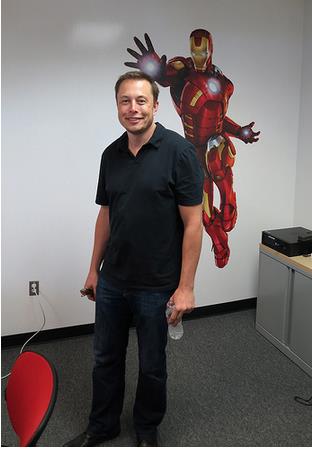 Of course, we’ve listened to Robert Downey, Jr. and know that he is really “Iron Man”. In fact, the SpaceX plant in California was used extensively during the shooting of Iron Man II. Just consider the image below of the antagonist arms dealer walking through his factory… all full of himself. Someone neglected to airbrush out of this scene the little SpaceX logo (located in the lower left of the shot… see inset) out of the filming of that scene (follow the arrow).
Of course, we’ve listened to Robert Downey, Jr. and know that he is really “Iron Man”. In fact, the SpaceX plant in California was used extensively during the shooting of Iron Man II. Just consider the image below of the antagonist arms dealer walking through his factory… all full of himself. Someone neglected to airbrush out of this scene the little SpaceX logo (located in the lower left of the shot… see inset) out of the filming of that scene (follow the arrow).
INSET: the SpaceX logo is circled in red.
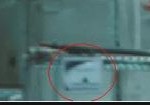
That said, although I love the Iron Man films and Avengers franchise, I confess that I do not have the stomach I need to “invest like Iron Man”! There is not enough Pepcid or Tums (or anything else) to help me overcome that shortcoming. And even if I did overcome the heartburn and gut-wrenching ache of volatility, I’d never survive the impact on my blood pressure!
I’ll stick with a diversified, risk-managed portfolio, thank you!
 DISCLOSURE: The author has traded TSLA and TAN (a solar ETF) and currently owns the latter. (SCTY is in the TAN portfolio). Nothing in this article is intended as a recommendation to buy or sell anything. Always consult with your financial advisor regarding changes in your portfolio – either subtractions or additions.
DISCLOSURE: The author has traded TSLA and TAN (a solar ETF) and currently owns the latter. (SCTY is in the TAN portfolio). Nothing in this article is intended as a recommendation to buy or sell anything. Always consult with your financial advisor regarding changes in your portfolio – either subtractions or additions.
[1] Trading secret: I have a copy of this image posted on my computer screen and have charged it with responsibility to blast my sorry self into an alternate universe if I ever dare violate one of my trading rules or decide to compromise my risk management!
[2] “Elon Musk makes no sense — and that's the reason I know him. When I was trying to bring the character of genius billionaire Tony Stark to the big screen in Iron Man, I had no idea how to make him seem real. Robert Downey Jr. said, “We need to sit down with Elon Musk.” He was right.” From: http://content.time.com/time/specials/packages/article/0,28804,1984685_1984745_1985495,00.html
[3] SES is a Dutch operator of communications spacecraft.
[4] And my editor is asking, as well!
[5] Remember, we just listed a number of “huge” aspects of SpaceX’s Falcon 9 launch!!
[6] Musk is Board Chair of SCTY, but not CEO. As we’ll see, he is a huge financial backer.
[7] It does make me mindful of the potential advantages of a robot (similar to a rocket) as a politician. Programmed correctly, they cannot lie, take a bribe, cheat, steal, etc!
[8] Especially compared with PHEV (Plug-in Hybrid Electric Vehicles).
[9] Many of which are as much to help financial professionals sell as to help “inform” an investor
[10] The gut’s “rumble” serves the same purpose as when someone rolls their eyes when someone else is “full of it”!
[11] For the record, TSLA dived 17.7% between 9/30 and 10/30; it tanked 31.85% between 11/5 and 11/26. Between 11/26 and 12/3 it zoomed up over 20%.
[12] No one knows gut wrenching like my gut!
[13] All worksheets created from YahooFinance.com data by Thomas R. Petty, C.F.P.
[14] Following up on the fires, two things: 1) German investigators released findings establishing that the fires were not a manufacturer defect; fires still under investigation by U.S. authorities; the news caused a big pop “up” in price in early December; 2) all cars are subject to fires; it would be shocking if a TSLA model did not experience some fires.
[15] Yes, you are right. At October 1st, the net worth would have been higher. But remember we are thinking “big picture” here!!
[16] Great idea in theory! In reality, once the Form 4 was released with the report of shares sold by Musk, the stock price would suffer greatly from Wall Street Angst!
[17] In case he is reading: “Hello, Elon! I’d do a great job for you, and I’d offer you my lowest ever “wrap fee”!
[18] Trust me, folks. If this was real life stuff, I’d diversify. We are in “theory” mode here!
[19] Now that is unkind! Likening me to Mr. Slowsky (on the Comcast Cable commercials) is downright cruel. Take it back!
Related Posts
Also on Market Tamer…
Follow Us on Facebook


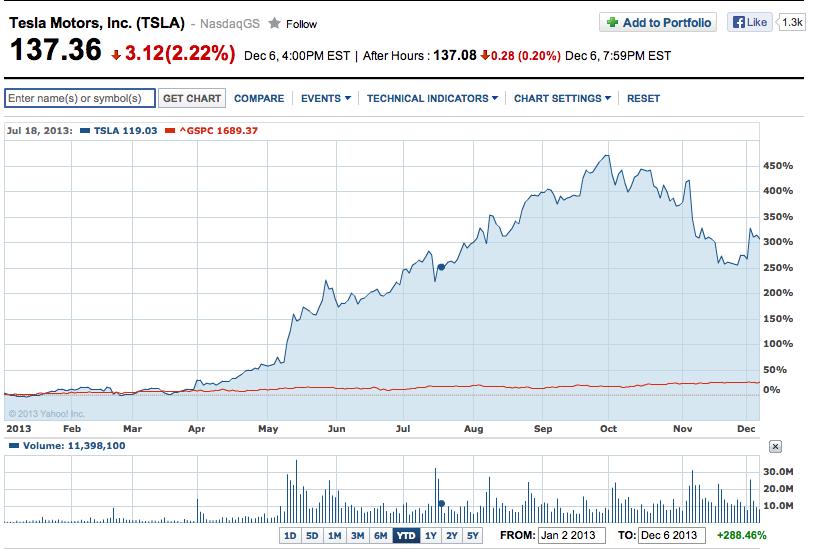
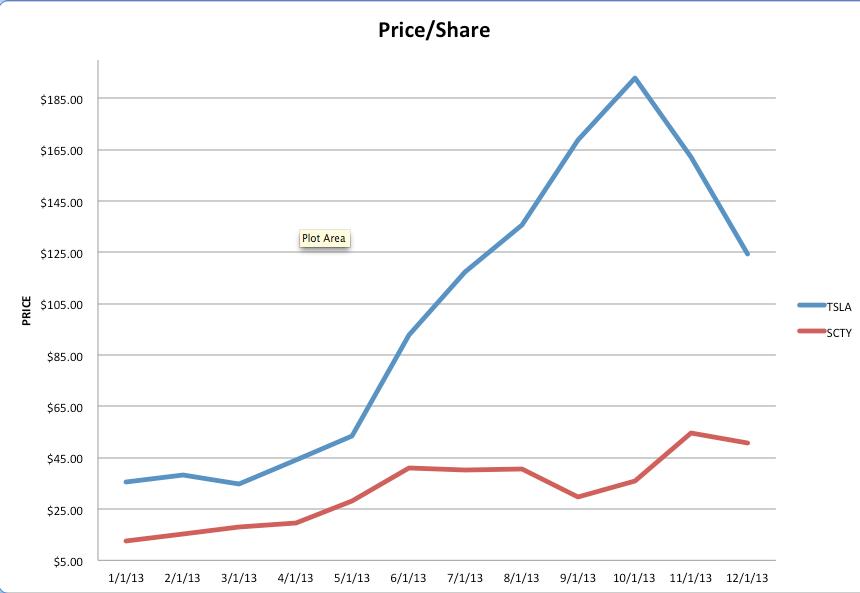
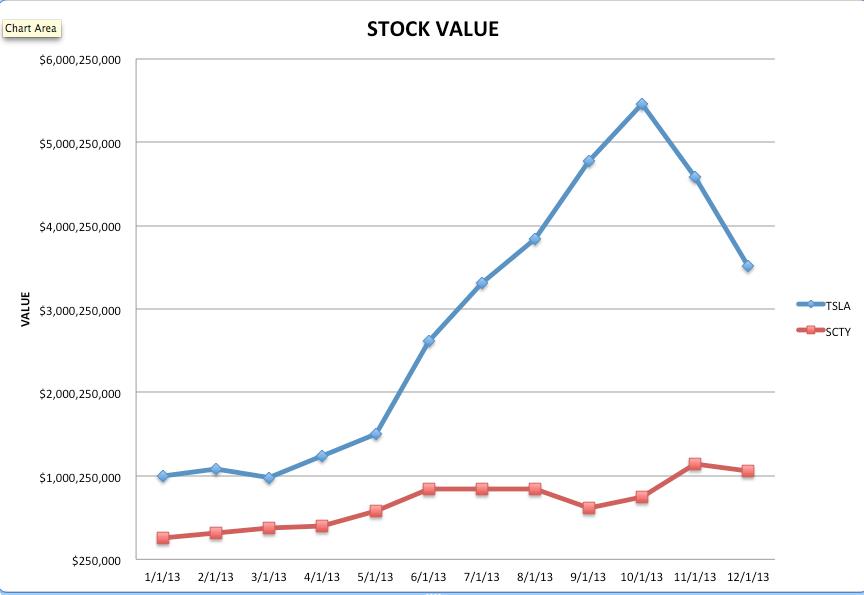
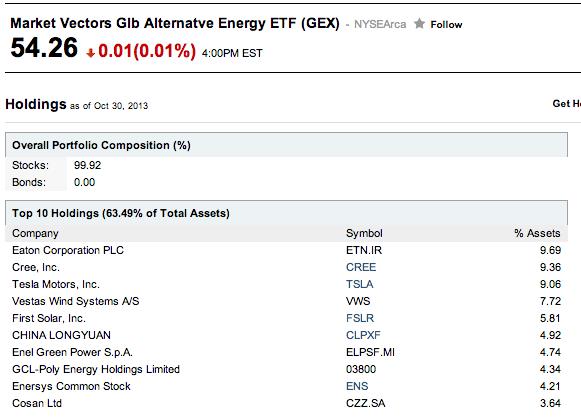
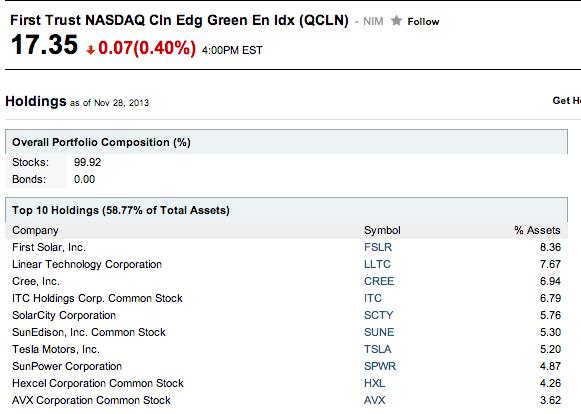
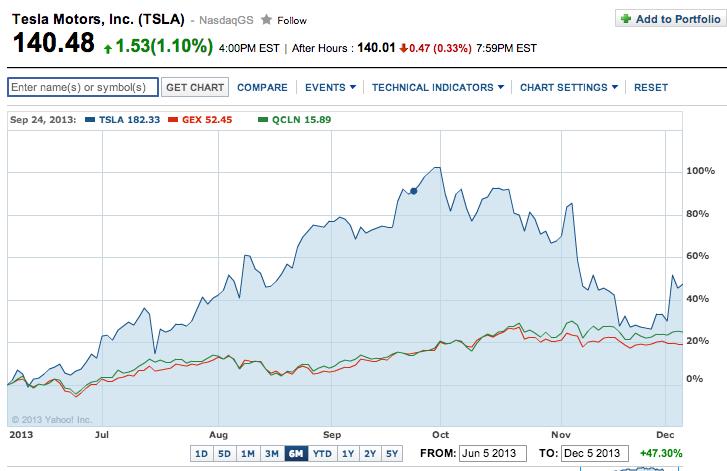
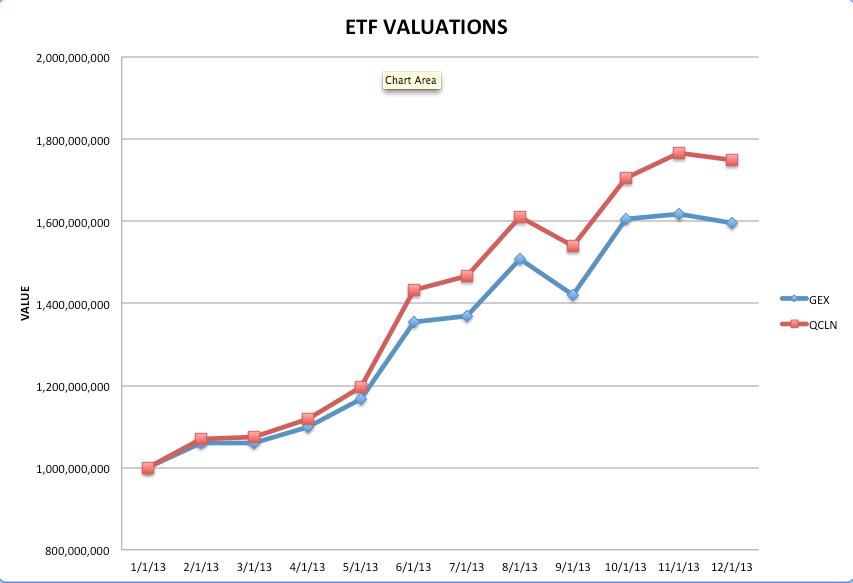
 Pros and Cons of Rolling Over Your 401(k) to an IRA
Pros and Cons of Rolling Over Your 401(k) to an IRA